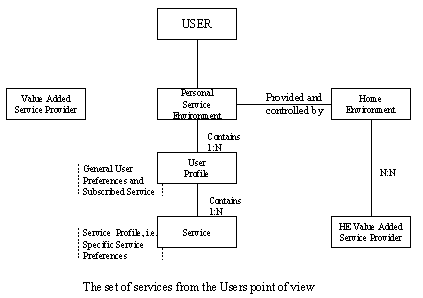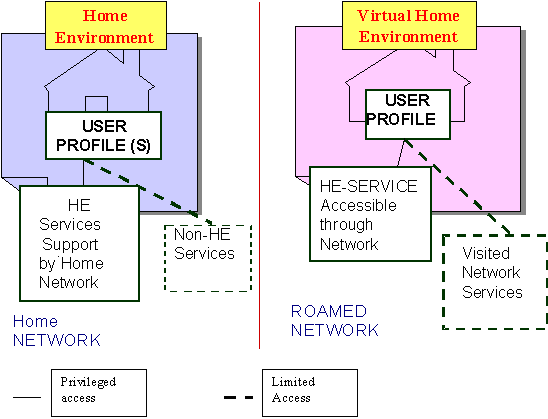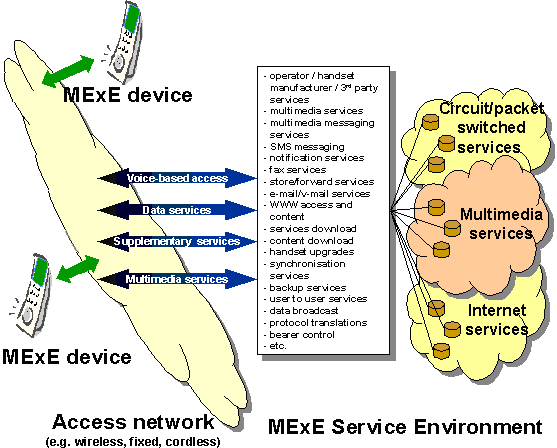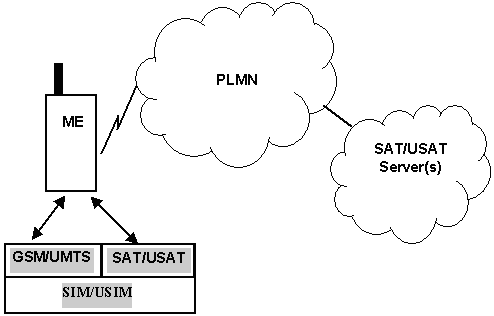Virtual Home Environment (VHE) is a concept for Personal Service Environment (PSE) portability across network boundaries and between terminals. The concept of VHE is such that users are consistently presented with the same personalised features, User Interface customisation and services in whatever network and whatever terminal (within the capabilities of the terminal and the network), wherever the user may be located. For Release 5,
CAMEL,
MExE,
OSA and
USAT are considered the mechanisms supporting the VHE concept.
CAMEL Customised Application For Mobile Network Enhanced Logic
MExE Mobile Execution Environment
MRF Media Resource Function
OSA Open Service Access
USAT Universal SIM Application Tool-Kit
A user's VHE is enabled by user profiles as logically depicted in a picture below. The home environment shall:
enable the user to manage one or more user profiles (e.g. activate, modify, deactivate etc.)
enable the home environment and HE-VASP to manage one or more user profiles (e.g. activate, modify, deactivate etc.)
enable the identification of a user's personalised data and services information directly or indirectly from the user's profile(s)
enable authorised HE-VASPs to access the user's profile(s)
enable VASPs controlled and limited access to the user's profile(s) (e.g. for general user preferences and subscribed services information).
The home environment's view of the Virtual Home Environment concept is logically depicted in a picture below. The home environment shall:
be able to provide and control services to the user in a consistent manner also if the user is roaming
provide the necessary means to create and maintain a set of user profiles
Support the execution of services – through its Service Toolkits in the network, the USIM and in the ME
uniquely identify the user in the telecommunication networks supported by the Home Environment.
Logical VHE Role Model (Operator's Home Environment's View)
The Open Service Access consists of three parts:
Applications: e.g. VPN, conferencing, location based applications. These applications are implemented in one or more Application Servers;
Framework: providing applications with basic mechanisms that enable them to make use of the service capabilities in the network. Examples of framework functions are Authentication and Discovery. The discovery function enables the application to find out which network service capability features are provided by the Service Capability Servers.
Service Capability Servers: providing the applications with service capability features, which are abstractions from underlying network functionality. Examples of service capability features offered by the Service Capability Servers are Call Control and User Location.
Mobile Execution Environment (MExE) provides a standardised execution environment in an UE, and an ability to negotiate its supported capabilities with a MExE service provider, allowing applications to be developed independently of any UE platform. The UE (consisting of the ME and SIM/USIM) can then be targeted at a range of implementations for MExE from small devices with low bandwidth, limited displays, low processor speeds, limited memory, MMI etc., to sophisticated with a complete MExE execution environment.
Generic MExE architecture
Universal Subscriber identity module Application Toolkit (USAT) provides a standardised execution environment for applications stored on the USIM/SIM card and the ability to utilize certain functions of the supporting mobile equipment. SAT/USAT provides mechanisms which allow applications, existing in the USIM/SIM, to interact and operate with any ME which supports the specified mechanism(s) thus ensuring interoperability between a USIM/SIM and an ME, independent of the respective manufacturers and operators. A transport mechanism is provided enabling applications to be down-loaded and/or updated.
USAT Diagram
|




No comments:
Post a Comment